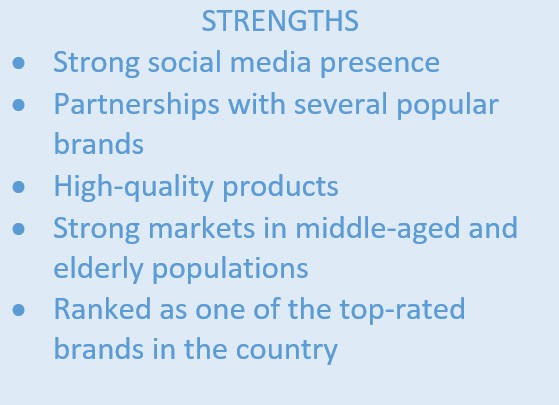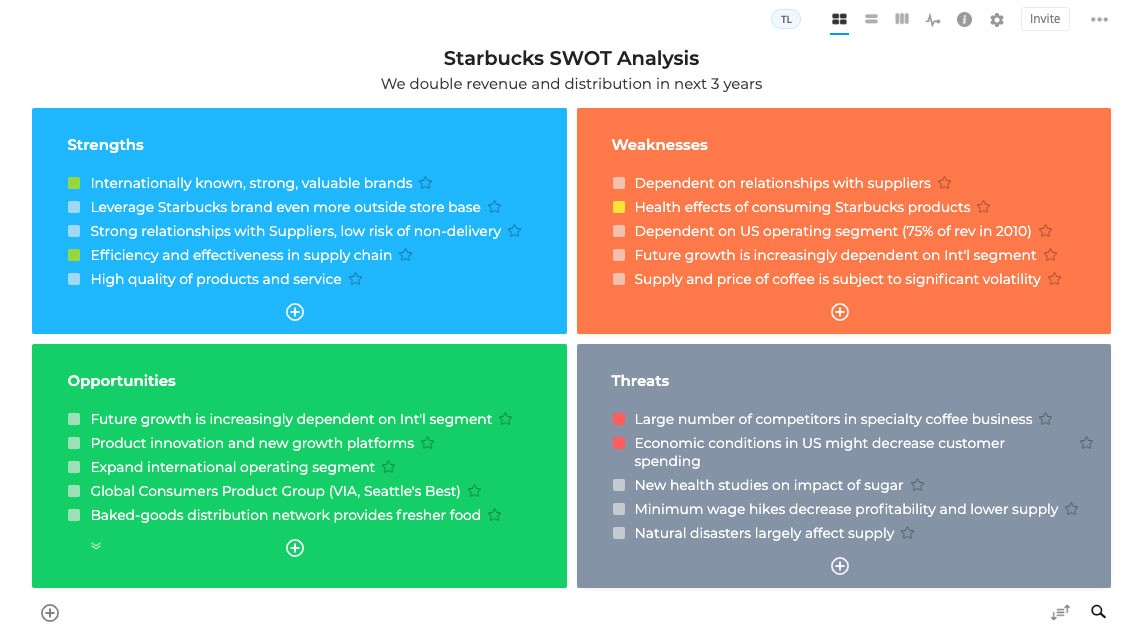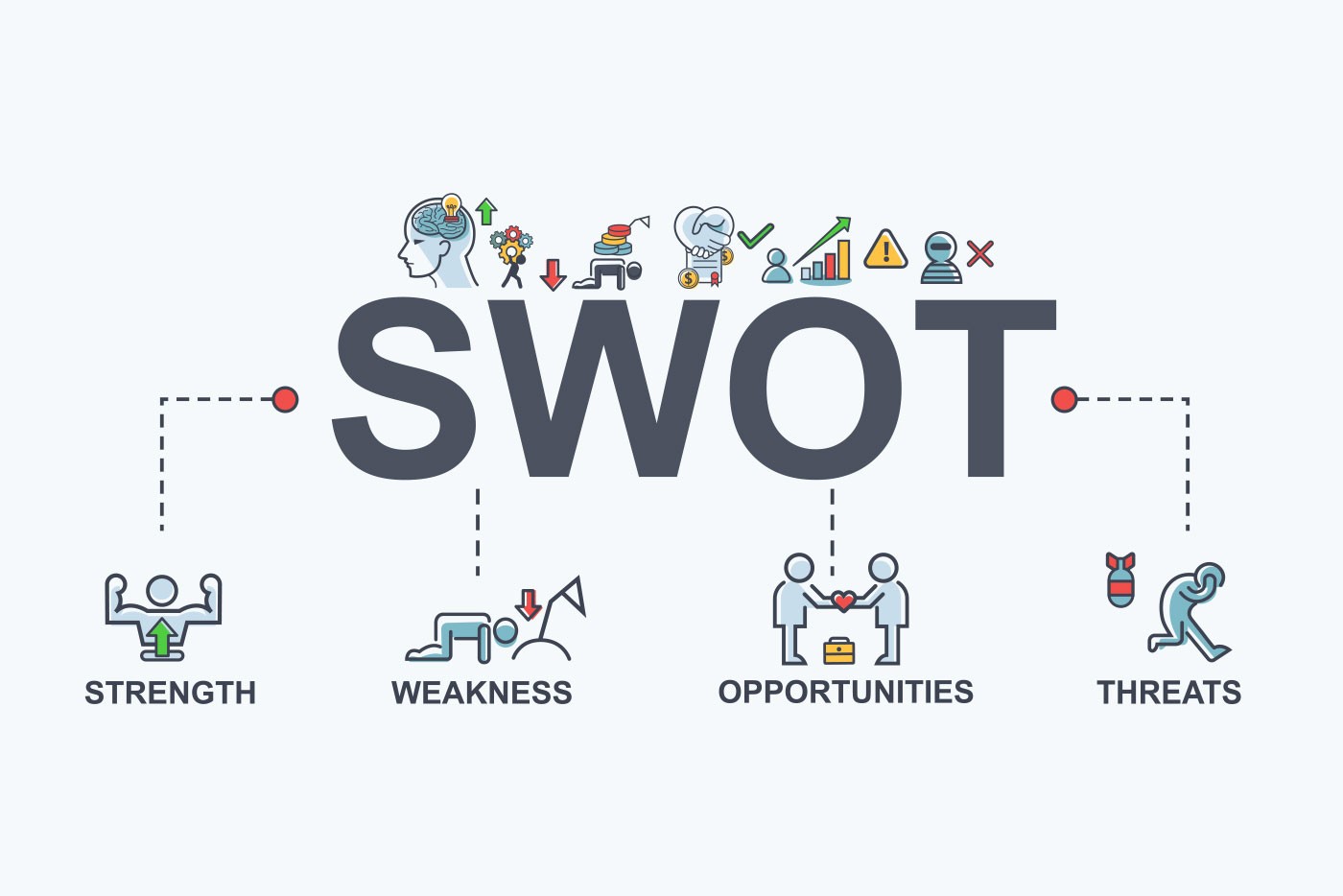As a business person, it is not unusual to aspire for your venture to flourish. But as much as big dreams are an essential fuel for development, finding the best strategy to realize them is never easy. However, scrutinizing your online business using a SWOT analysis template may take you a step closer to success.
A SWOT analysis of a company tables the internal and external factors strengthening or threatening a business’s existence. After carrying it out, enterprises are better prepared to capitalize on opportunities and adapt to looming industry changes. In truth, SWOT analysis presents an ideal way to get a bird’s eye view of a company’s operations and its industrial position.
Given the role a SWOT analysis plays in a business’s success, understanding it in depth is almost a must-do for entrepreneurs. If you are a small business proprietor wondering how to execute a SWOT analysis, you should find this piece to be extremely resourceful.
Are you prepared to cover business and website SWOT analysis to the nth degree? Here you go.
What Is A SWOT Analysis?
SWOT (pronounced swat) stands for strengths, weaknesses, opportunities, and threats. Thus, a SWOT analysis is a procedure for determining a business’s strong and weak points, available opportunities, and impending threats.
However, SWOT analysis does not apply to businesses only. You can examine your own analysis after checking a personal SWOT analysis example. Remember, a successful venture requires a sound, rational mind to run. Thus, it would make sense to look into your business/website objectively.
Further, organizations can carry out SWOT analysis for specific projects. For example, if your company happens to be running a marketing campaign, it is prudent to examine whether it realizes the objectives you set it to achieve.
The parties involved in a SWOT analysis depend on the subject in question. For example, organizational analysis requires that you brainstorm with members from different firm levels and departments. Personal inquiries may need people that know you very well. By and large, you will want to include all those who can contribute to the achievement of your set objectives.
If you are an online business operator, then it is advisable to separate SWOT analysis, one for your business and one for your website. Here is what you need to look at.
How to Do a SWOT Analysis for Your Business
You can begin conducting a SWOT analysis formally or informally. Some analysis tools allow you to initiate conversations and provide a method for parties to give feedback. However, if your firm does not have the financial muscle to shoulder the overhead associated with such tools, you can brainstorm. Whatever method you use to carry out the analysis, there three main steps involved:
-
Determine the Objective of the Analysis
Without a clear goal as to why you are conducting a SWOT analysis, determining the best way to carry it out becomes problematic. Mostly, deciding the objective of the analysis is the business leadership’s task. But there is no harm in involving middle-level staff.
Note that the objective should be concise. Thus, it is logical to keep off general statements like “being more successful.” Instead, formulate distinct aims such as “determine whether to market product x in area y.” Clarified goals inform on what areas of the business to zoom in and center on.
-
Developing the SWOT Analysis Matrix
Having set the reasons for undertaking a SWOT analysis, you can continue developing an analysis matrix. Typically, it is a rectangle with four quadrants. The first carries the title “Strengths” while the adjacent quadrant’s title is “Weaknesses.” The third and fourth quadrants’ headings are “Opportunities” and “Threats” respectively.
If you run into trouble when developing the matrix’s format, be sure to look for SWOT analysis examples for students online. There are also numerous websites providing templates and personal SWOT analysis examples. All you have to do is download and modify the prototypes to suit your specific needs. Here is an example of a SWOT template:

(Image Credit: Aha!)
Test your SEO in 60 seconds!
Diib is one of the best SEO tools in the world. Diib uses the power of big data to help you quickly and easily increase your traffic and rankings. We’ll even let you know if you already deserve to rank higher for certain keywords.
- Easy-to-use automated SEO tool
- Keyword and backlink monitoring + ideas
- Speed, security, + Core Vitals tracking
- Intelligently suggests ideas to improve SEO
- Over 500,000k global members
- Built-in benchmarking and competitor analysis
Used by over 500k companies and organizations:
Syncs with 
You Might Also Like
-
Fill the Matrix
Once you have the SWOT analysis matrix in the preferred format, it is time to populate it with content. This stage is the meat of the story, and what you fill here determines your SWOT analysis’s resourcefulness. The following is the information to place under specific matrix elements.
Strengths
Strengths are internal factors that set your business apart from its competitors. Internal, in this sense, means that strengths are under the control of your business. They include:
- A motivated staff
- An exceptionally skilled team
- Superior production methods
- Intellectual property such as patents
- Sole access to raw material
- Excellent leadership

(Image Credit: Cacoo)
As you can see, strengths are items your company excels in exceptionally. Thus, some businesses refer to them as internal positives. As a proprietor, you might think that articulating your strengths is a piece of cake. On the contrary, it may turn out to be something you will sweat over.
To ease the process, experts recommend answering the following questions as honestly as possible:
- What merits does your business have over competitors?
- Compared to competitors, how skilled are your employees and their leadership?
- What positive brand attributes do you have?
- Is your R&D wing superior to competitors?
- How is networked is your business?
- What do customers love about your business?
- Are there particular assets that only your business can access, such as patents, credit lines, and technology?
Weaknesses
Weaknesses are internal factors that downgrade your competitive advantage. Simply put, they are challenges that inhibit your business’s ability to compete. They include:
- Limited resources – human, financial, and technological resources
- Negative perception by the market
- An unclear unique selling proposition (USP)
- Poor business location

(Image Credit: Cacoo)
The questions to answer in this section are:
- Do you have a sound capital base?
- What does the customer dislike about your business?
- Is your business location poor?
- Does your business lack resources that competitors have?
- What makes your business lose clients?
Opportunities
Opportunities are factors that provide a chance for your business to grow. As they are external, your company cannot control them. However, you can pursue them and increase revenues. Remember, your competitors may see them too. Thus, decisions to exploit opportunities are time-sensitive.
Opportunities include:
- A small number of competing firms
- New markets for your products
- Shortages in the market
- A fresh supply of resources

(Image Credit: Cacoo)
Some of the questions to look into when assessing opportunities are:
- Is there an existing or expected market growth?
- Are there government policies that changed in favor of your business?
- Are there unexploited resources in your business?
- Is there new resourceful technology that your business can acquire but have not?
- How can your business increase revenues?
Threats
Threats are factors that risk the success of your business. As they are external, you cannot prevent them, but you may prepare for the worst. Exemplary threats include:
- Change of consumer behavior in favor of your competitors’ products
- New products that render yours obsolete
- Market declines
- Inflation, especially on the supply side

(Image Credit: Cacoo)
Subsequently, the questions to answer when assessing threats are:
- Are there impending shortages in the labor market?
- What new laws threaten the success of your business?
- Are there supply chain disruptions that can affect your ability to satisfy demand?
- Are there market shifts that obstruct business growth?
- Who are the emerging competitors threatening your business’s growth and existence?
There goes the answer to “how to do a SWOT analysis for your business.” If you developed a matrix after going over personal SWOT analysis examples, be sure to fill every quadrant with answers from the questions above.
What to Do With Your Business SWOT Analysis
After carrying out the SWOT analysis of a company, you need to act on it. As mentioned, the analysis is a strategic tool used to improve the competitiveness of a firm. But how do you use the SWOT analysis?
Firstly, it is a good idea to boost your strengths. As these are factors you already excel in, there is no need to change a thing. The business should continue pressing on to what it is doing. On the weaknesses part, however, you should figure a way to do away with internal flaws. Try to be creative here. For example, if your business is too small to compete with an established supplier, develop a personal touch that clients cannot get from the recognized competitor.
On the external factors, the business should exploit opportunities and mitigate threats. If there is a new market for your products, you can better your delivery method and explore ways to cut shipping rates or delivery times.
Finally, they can try to guard against the downside of a threat materializing. For example, a new competitor coming into play may cause your business to reduce prices to gain competitiveness. Such an action can reduce your profit margin, but it is necessary if your business’s life depends on it.
We hope that you found this article useful.
If you want to know more interesting about your site health, get personal recommendations and alerts, scan your website by Diib. It only takes 60 seconds.
How to Conduct a SWOT Analysis for Your Website
If you happen to be operating an online business, conducting a SWOT analysis for your business is not enough. It is imperative that you give your website a similar objective look and discover ways to improve it. Luckily, the process of examining a website is relatively easy. After reviewing a sample SWOT analysis for students, you may get started.
The definition of terms in a website’s SWOT analysis remains to be the same. Strengths and weaknesses remain to be the internal positive and negative factors. Similarly, opportunities and threats are external positives and negatives.
Like examining a business, a website SWOT analysis starts by articulating the objectives. However, website goals need to be not only concise but also measurable. The rule of thumbs is to attach a metric to the aim. For example, targets like “to decrease customer acquisition costs by x%” are ideal. It may be worthwhile to review a SWOT analysis example to formulate good intentions.
However, the questions to answer when conducting a website SWOT analysis differ significantly from those of a business examination. After checking a personal SWOT analysis example and developing the SWOT matrix, you can delve deeper into your website and scrutinize four core items.
Strengths
Examining the strength element pushes you into understanding what differentiates your website from those of competitors. While you may check a SWOT analysis example to explore internal strength factors, the questions you should answer here are:
- Does the website have fresh, quality, and relevant content?
- Is there a modern design implemented on the site?
- How well does the website support mobile users?
- Are the call-to-actions sending the right message to customers?
- Is your web host performance optimal?
Weaknesses
Your website’s weaknesses consist of factors that make your competitors’ websites superior to yours. This definition does not mean that you must check competing sites to conclude on your site’s condition. Any internal negative factors feature here. The queries to answer under weaknesses are:
- Is your website’s checkout process long?
- Do you have a live chat or other functional messaging systems?
- Is the user interface (UI) poor?
- Are mobile users having trouble accessing or navigating your website?
- Does your content capture a customer’s attention?
Opportunities
These are external possibilities for making your website better. Some opportunities only exist in the future. Thus, it would be good to involve an analyst in this stage for better insights. All in all, the questions to answer here are:
- Is there a new design tool to improve the user interface and user experience?
- Are there new technologies to improve website functions such as checkout?
- Is there a cheaper way to market the website, such as SEO?
- What are the emerging markets your business can serve through the website?
Threats
External factors that limit the ability of your website to contribute to business growth are threats. Sample questions for this quadrant are:
- Are there new websites cropping up to compete with yours?
- Do there exist new laws that make operating through your website illegal?
- Can malicious actors try to hack your website?
- Can competitors copy your web design idea and features?
- Are customer tastes changing such that they might no longer use your website?
You can avoid going into a SWOT analysis blind by checking what other businesses are doing. A good idea would be going over SWOT analysis examples for students and other businesses. For instance, here is an example of a SWOT done for Starbucks:

(Image Credit: SWOT Analysis)
What to Do With Your Website SWOT Analysis
Like business analyses, you can start implementing solutions from the website SWOT analysis by capitalizing on strengths. Further, you can take advantage of opportunities and propel your business to new heights.
As for weaknesses, you can try turning them into strengths. Unlike a business setting where managerial expertise must be present, website restructuring only requires a talented developer. Thus, converting weaknesses to strong points is faster. However, threats are much harder to guard against. You can evade threats like hacking, but it may involve a substantial investment.
Why Is a SWOT Analysis Important?
While business and website SWOT analyses vary in the details, there is no argument that they are an essential part of company success. There are three chief reasons why conducting a SWOT analysis will be beneficial to your firm.
Resource Allocation
A SWOT analysis reveals business faculties that are not using resources efficiently. It further recommends the optimal ways to allocate the wasted resources. With increased efficacy, your venture is in a better position to grow.
Ability to Adapt
Getting a clear picture of the threats facing your business is an eye-opener. You realize that the only way your firm can through economic cycles is by re-inventing itself. A SWOT analysis goes a step further and informs how to adapt when preparing for an unknown future and exploiting a new opportunity.
Gaining a Competitive Edge
A SWOT analysis’s core objective is to determine a business’s position in relation to its competitors. By understanding what you can do to perform better, you create a competitive edge that other firms may not achieve. Further, you can take advantage of opportunities before competing ventures see them and gain the first-mover merit.
Diib®: Review Many of Your SWOT Analysis Metric Here!
While the desire to attain business success is common to all proprietors, the ability is not. Those who understand their businesses to the tiniest bit are in a unique position to change it for the better. Undoubtedly, an examination using a SWOT analysis template presents the most straightforward way to know your company. However, Diib Digital gives you the unique opportunity to view and examine many of the metrics involved in a SWOT analysis as part of your daily review on a custom User Dashboard. Here are some of the features that set us apart from the crowd:
- Bounce rate monitoring and repair
- Social media integration and performance
- Broken pages where you have backlinks (404 checker)
- Keyword, backlink, and indexing monitoring and tracking tools
- User experience and mobile speed optimization
- SEO score monitoring
Click here for your free scan or simply call 800-303-3510 to speak to one of our growth experts
FAQ’s
To conduct a SWOT analysis you must:
- Determine your objective for the SWOT analysis.
- Complete research on your business and/or organization.
- Form a list of your businesses strengths and weaknesses.
- Write down potential opportunities and threats.
- Determine your priorities based on the information you have gathered doing the SWOT analysis.
When looking for examples first turn towards your competitors. The SWOT analysis should look like a simple two-by-two grid that easily organizes your strengths, weaknesses, opportunities and threats.
A SWOT analysis helps you identify what you are doing well and how to build upon that and how to address your weaknesses and overcome them. It also helps you notice the risks upon your business and how to avoid them. Finally, it helps you see the opportunities you could be taking advantage of and encourages you to seize them.
The most difficult part of a SWOT analysis is usually figuring out the opportunities you have. This is because if you knew your opportunities you would have most likely already seized them.
All of the SWOT analysis is important however, pinpointing your businesses opportunities and threats tend to be a bit more important. The reason for this is because you want to be able to take advantage of of the opportunities at your grasp as soon as possible and eliminate any threat that might come into play.




Ravi Varma says:
If your website is ranking on a search engine by paying money and running ads
on that search engine then we call them as inorganic search results.
Gcandy Mini says:
I agree with you that referrals from Google advertising cannot be classified as organic traffic.